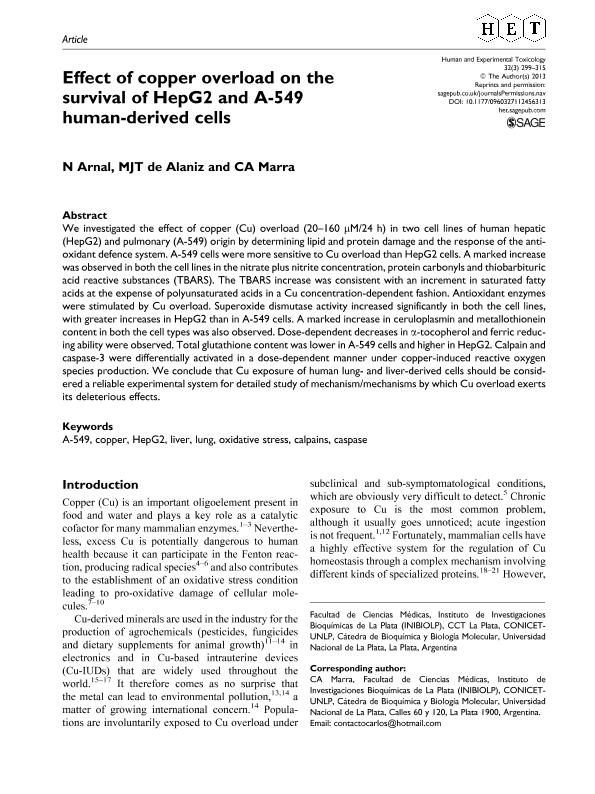Artículo
Effect of copper overload on the survival of HepG2 and A-549 human-derived cells
Fecha de publicación:
03/2013
Editorial:
Sage Publications Ltd
Revista:
Human and Experimental Toxicoloxy
ISSN:
0960-3271
Idioma:
Inglés
Tipo de recurso:
Artículo publicado
Clasificación temática:
Resumen
We investigated the effect of copper (Cu) overload (20-160 μM/24 h) in two cell lines of human hepatic (HepG2) and pulmonary (A-549) origin by determining lipid and protein damage and the response of the antioxidant defence system. A-549 cells were more sensitive to Cu overload than HepG2 cells. A marked increase was observed in both the cell lines in the nitrate plus nitrite concentration, protein carbonyls and thiobarbituric acid reactive substances (TBARS). The TBARS increase was consistent with an increment in saturated fatty acids at the expense of polyunsaturated acids in a Cu concentration-dependent fashion. Antioxidant enzymes were stimulated by Cu overload. Superoxide dismutase activity increased significantly in both the cell lines, with greater increases in HepG2 than in A-549 cells. A marked increase in ceruloplasmin and metallothionein content in both the cell types was also observed. Dose-dependent decreases in α-tocopherol and ferric reducing ability were observed. Total glutathione content was lower in A-549 cells and higher in HepG2. Calpain and caspase-3 were differentially activated in a dose-dependent manner under copper-induced reactive oxygen species production. We conclude that Cu exposure of human lung- and liver-derived cells should be considered a reliable experimental system for detailed study of mechanism/mechanisms by which Cu overload exerts its deleterious effects.
Palabras clave:
A-549
,
CALPAINS
,
CASPASE
,
COPPER
,
HEPG2
,
LIVER
,
LUNG
,
OXIDATIVE STRESS
Archivos asociados
Licencia
Identificadores
Colecciones
Articulos(INIBIOLP)
Articulos de INST.DE INVEST.BIOQUIMICAS DE LA PLATA
Articulos de INST.DE INVEST.BIOQUIMICAS DE LA PLATA
Citación
Arnal, Nathalie; de Alaniz, M. J. T.; Marra, Carlos Alberto; Effect of copper overload on the survival of HepG2 and A-549 human-derived cells; Sage Publications Ltd; Human and Experimental Toxicoloxy; 32; 3; 3-2013; 299-315
Compartir
Altmétricas




